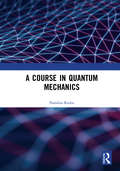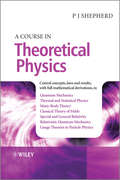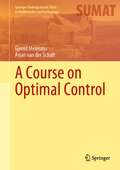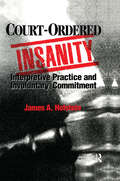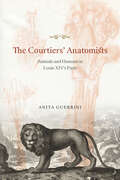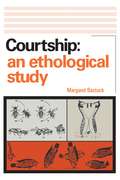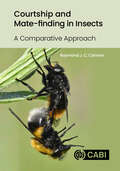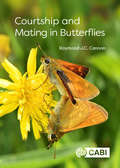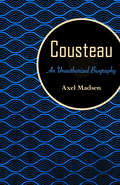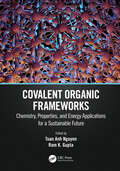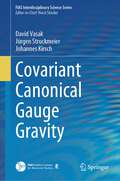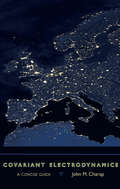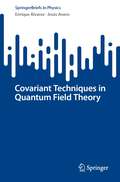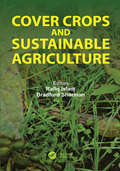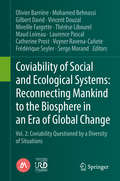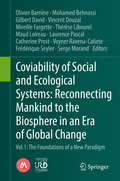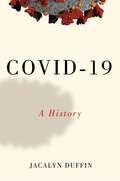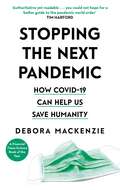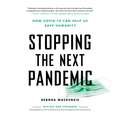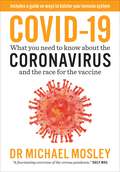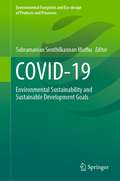- Table View
- List View
A Course in Quantum Mechanics
by Nandita RudraThe book is suitable for graduate and advanced level undergraduate students. Besides standard materials for the course, it also includes modern topics like coherent states, propagators and Feynman's path integral method, Landau levels, Aharonov Bohm Effect, parity operation, time reversal symmetry and Dirac relativisticequation.Please note: Taylor & Francis does not sell or distribute the Hardback in India, Pakistan, Nepal, Bhutan, Bangladesh and Sri Lanka
A Course in Theoretical Physics
by P. John ShepherdThis book is a comprehensive account of five extended modules covering the key branches of twentieth-century theoretical physics, taught by the author over a period of three decades to students on bachelor and master university degree courses in both physics and theoretical physics. The modules cover nonrelativistic quantum mechanics, thermal and statistical physics, many-body theory, classical field theory (including special relativity and electromagnetism), and, finally, relativistic quantum mechanics and gauge theories of quark and lepton interactions, all presented in a single, self-contained volume. In a number of universities, much of the material covered (for example, on Einstein’s general theory of relativity, on the BCS theory of superconductivity, and on the Standard Model, including the theory underlying the prediction of the Higgs boson) is taught in postgraduate courses to beginning PhD students. A distinctive feature of the book is that full, step-by-step mathematical proofs of all essential results are given, enabling a student who has completed a high-school mathematics course and the first year of a university physics degree course to understand and appreciate the derivations of very many of the most important results of twentieth-century theoretical physics.
Course Lab Manual: BI 101 Worcester State University
by Mcgraw-Hill EducationConcepts of Biology Lab Manual
A Course on Optimal Control (Springer Undergraduate Texts in Mathematics and Technology)
by Gjerrit Meinsma Arjan van der SchaftThis text provides a detailed and self-contained introduction to the core topics of optimal control for finite-dimensional deterministic dynamical systems. Skillfully designed to guide the student through the development of the subject, the book provides a rich collection of examples, exercises, illustrations, and applications, to support comprehension of the material. Solutions to odd-numbered exercises are included, while a complete set of solutions is available to instructors who adopt the text for their class. The book is adaptable to coursework for final year undergraduates in (applied) mathematics or beginning graduate students in engineering. Required mathematical background includes calculus, linear algebra, a basic knowledge of differential equations, as well as a rudimentary acquaintance with control systems. The book has developed out of lecture notes that were tested, adapted, and expanded over many years of teaching. Chapters 1-4 constitute thematerial for a basic course on optimal control, covering successively the calculus of variations, minimum principle, dynamic programming, and linear quadratic control. The additional Chapter 5 provides brief views to a number of selected topics related to optimal control, which are meant to peak the reader’s interest. Some mathematical background is summarized in Appendix A for easy review. Appendix B recalls some of the basics of differential equations and also provides a detailed treatment of Lyapunov stability theory including LaSalle’s invariance principle, as occasionally used in Chapters 3 and 4.
Court-Ordered Insanity: Interpretive Practice and Involuntary Commitment (Social Problems And Social Issues Ser.)
by James A. HolsteinThis book, about involuntary commitment proceedings, focuses on interpretive practice at the nexus of legal, psychiatric, and practical reasoning. It describes the interactional dynamics through which legally and psychiatrically warranted decisions are publicly argued, negotiated, and justified.
The Courtiers' Anatomists: Animals and Humans in Louis XIV's Paris
by Anita Guerrini"The Courtiers' Anatomists" is about dead bodies and live animals in Louis XIV's Paris--and the surprising links between them. Examining the practice of seventeenth-century anatomy, Anita Guerrini reveals how anatomy and natural history were connected through animal dissection and vivisection. Driven by an insatiable curiosity, Parisian scientists, with the support of the king, dissected hundreds of animals from the royal menageries and the streets of Paris. Guerrini is the first to tell the story of Joseph-Guichard Duverney, who performed violent, riot-inducing dissections of both animal and human bodies before the king at Versailles and in front of hundreds of spectators at the King's Garden in Paris. At the Paris Academy of Sciences, meanwhile, Claude Perrault, with the help of Duverney s dissections, edited two folios in the 1670s filled with lavish illustrations by court artists of exotic royal animals. Through the stories of Duverney and Perrault, as well as those of Marin Cureau de la Chambre, Jean Pecquet, and Louis Gayant, "The Courtiers' Anatomists" explores the relationships between empiricism and theory, human and animal, as well as the origins of the natural history museum and the relationship between science and other cultural activities, including art, music, and literature. "
Courtship: An Ethological Study
by Margaret BastockThis concise but thorough study of courtship behavior in fish, birds, and arthropods is the first rigorous examination of the evolutionary origins and mechanisms of courtship and its contribution to biological success. Demonstrating the fruitfulness of an empirically based, inductive approach to understanding courtship, the book also explains clearly how principles of modern evolutionary theory can be successfully employed in studying behavior.The author describes many observations and experiments that have not previously appeared outside specialized journals and brings an abundance of simple yet accurate examples of animal behavior to bear on explanations of ethological concepts and evolutionary theory. No attempt is made to skim over the gaps of knowledge apparent in the study of behavior evolution; rather, the author discusses the limitations and difficulties of different approaches, critically reviews the deductions that can be and have been made from them, and tries to present enough evidence on controversial points for the reader himself to judge the validity of specific arguments.Indicating how ethological method, firmly based on biological principles, can intensively investigate and illuminate a single area of animal behavior, the book will be valuable to students and professionals in zoology, animal behavior, and experimental psychology.
Courtship and Mate-finding in Insects: A Comparative Approach
by Raymond J CannonThis book explores mate-finding and courtship behaviour in the insect world, in all its subtlety and diversity. Insects engage in courtship as much, or as little, as any other animal; they have songs and dances, and all manner of instruments and ornaments to attract and court the opposite sex. Insects have evolved complex chemical and acoustic communication systems, sending fragrant messages, visual signals and subtle vibrations to attract and persuade. Insects also have many different ways and means of choosing or rejecting mating partners. This beautifully illustrated book shows the incredible variety of courtship behaviours and celebrates the wonderful natural history of a wide range of insects. Varieties of courtship can occur before, during and even after copulation, and numerous examples of the different mating strategies used are presented. As well as being fascinating and entertaining, studying courtship is also useful. For example, a knowledge of the courtship and mating behaviour of important pests helps researchers understand the dynamics of mate choice and sexual selection. Knowing which behaviours are directly related with mating success can be used to improve behaviour-based control strategies and improve sterile insect techniques. Knowledge of sex pheromones, and mating behaviour, can be combined to manage insect pests by mass or mating disruption. By studying model species - such as the fruit fly, Drosophila melanogaster - researchers have discovered how genes control and influence courtship behaviour, via proteins, biochemical pathways and neural circuits. This book integrates these diverse fields into a framework constructed around courtship and mate-finding, bringing together studies from the laboratory and the field. This landmark volume will be of interest to students of biology, entomologists, naturalists and anyone with a desire to know more about the love lives of the small creatures with which we share the planet.
Courtship and Mating in Butterflies
by Raymond J.C. CannonThis book presents a readable account of butterfly behaviour, based on field observations, great photographs and the latest research. The main focus is on courtship and mating - including perching, searching and territorial behaviour - but to understand these subjects it is necessary to explain how mates are chosen and this requires sections on wing colours and patterns. A chapter on butterfly vision is also essential in terms of how butterflies see the world and each other. There have been exciting discoveries in all of these fields in recent years, including: butterfly vision (butterfly photoreceptors), wing patterns (molecular biology), wing colouration (structural colours and nano-architecture), mating strategies and female choice (ecology and behaviour).
Cousteau
by Axel MadsenOne of the most influential men of the twentieth century, Jacques Cousteau was an eco-emissary whose own life of derring-do brought him fame and the means to proselytize his cause. Ecologist, adventurer, celebrity, businessman--Cousteau was a brilliant and complex individual, and Madsen's biography captures him in style. Madsen, who knew the Cousteau family for over two decades, interviewed Cousteau personally for this book.
Covalent Organic Frameworks: Chemistry, Properties, and Energy Applications for a Sustainable Future
by Tuan Anh Nguyen Ram K. GuptaCovalent organic frameworks-based nanomaterials have emerged as promising candidates for energy applications owing to their superior electrochemical properties, surface area, nano-device integration, multifunctionality, printability, and mechanical flexibility. This book provides fundamentals, various synthesis approaches, and applications of covalent organic frameworks-based nanomaterials and their composites for generating energy. The main objective of this book is to provide current, state-of-the-art knowledge about covalent organic frameworks-based nanomaterials and their composites for supercapacitors, batteries, photovoltaics, and fuel cells, covering almost the entire spectrum in the energy field under one title. Aimed at widening our fundamental understanding of covalent organic frameworks and mechanisms for realization and advancement in devices with improved energy efficiency and high storage capacity, this book will provide new directions for scientists, researchers, and students to better understand the principles, technologies, and applications of covalent organic frameworks.
Covariant Canonical Gauge Gravity (FIAS Interdisciplinary Science Series)
by David Vasak Jürgen Struckmeier Johannes KirschThis book starts with the mathematical basis of the theory - i.e. provide a brief sketch of the theory of manifolds and frame bundles, tensors and their transformations, relativistic kinematics, and aspects of non-flat space-time geometries. The definition of relevant physical quantities (torsion, curvature, non-metricity, tetrads, connection fields etc.) and important geometry concepts are also included. The main body of the book is devoted to a detailed derivation of the gauge theory of gravitation for scalar, vector (Proca and Maxwell) and Dirac spinor fields. Alternative approaches based on the Noether theorem and on the spinorial representation of the fields are also addressed, as well as important novel features related to the CCGG framework (Birkhoff theorem, field derivative identities etc.). In the last section of the volume the application of the CCGG theory to cosmology will be set out, resulting in a new understanding of dark energy and inflation.
Covariant Electrodynamics: A Concise Guide
by John M. CharapA notoriously difficult subject, covariant electrodynamics is nonetheless vital for understanding relativistic field theory. John M. Charap’s classroom-tested introduction to the mathematical foundations of the topic presents the material in an approachable manner.Charap begins with a historical overview of electrodynamics and a discussion of the preliminary mathematics one needs in order to grasp the advanced and abstract concepts underlying the theory. He walks the reader through Maxwell’s four equations, explaining how they were developed and demonstrating how they are applied. From there, Charap moves through the other components of electrodynamics, such as Lorentz transformations, tensors, and charged particle behavior. At each point, he carefully works through the mathematics, applies the concepts to simple physical systems, and provides historical context that makes clear the connections among the theories and the mathematicians responsible for developing them. A concluding chapter reviews the history of electrodynamics and points the way for independent testing of the theory.Thorough, evenly paced, and intuitive, this friendly introduction to high-level covariant electrodynamics is a handy and helpful addition to any physicist’s toolkit.
Covariant Loop Quantum Gravity
by Carlo Rovelli Francesca VidottoQuantum gravity is among the most fascinating problems in physics. It modifies our understanding of time, space and matter. The recent development of the loop approach has allowed us to explore domains ranging from black hole thermodynamics to the early Universe. This book provides readers with a simple introduction to loop quantum gravity, centred on its covariant approach. It focuses on the physical and conceptual aspects of the problem and includes the background material needed to enter this lively domain of research, making it ideal for researchers and graduate students. Topics covered include quanta of space; classical and quantum physics without time; tetrad formalism; Holst action; lattice QCD; Regge calculus; ADM and Ashtekar variables; Ponzano-Regge and Turaev-Viro amplitudes; kinematics and dynamics of 4D Lorentzian quantum gravity; spectrum of area and volume; coherent states; classical limit; matter couplings; graviton propagator; spinfoam cosmology and black hole thermodynamics.
Covariant Techniques in Quantum Field Theory (SpringerBriefs in Physics)
by Enrique Álvarez Jesús AneroThe purpose of this book is to illustrate some of the most important techniques which are helpful in combinatorial problems when computing quantum effects in covariant theories, like general relativity. In fact, most of the techniques find application also in broader contexts, such as low energy effective (chiral) Lagrangians or even in specific problems in condensed matter. Some of the topics covered are: the background field approach and the heat kernel ideas. The arguments are explained in some detail and the presentation is meant for young researchers and advanced students who are starting working in the field. As prerequisite the reader should have attended a course in quantum field theory including Feynman’s path integral. In the Appendix a nontrivial calculation of one-loop divergences in Einstein-Hilbert gravity is explained step-by-step.
Cover Crops and Sustainable Agriculture
by Rafiq Islam and Bradford ShermanThis book will not serve as the "encyclopedia of cover crop management," but it’s close. The benefits of a wide range of individual cover crops and blends/mixes for specific agronomic crop rotations and geographic locations are included. Descriptions, photographs, and illustrations show how cover crops look in the field, including plant height, leaf architecture, and rooting patterns. Long term benefits are described for soil health, soil structure, water quality, nutrient contributions, soil biodiversity, air quality and climate change. In addition to the "whys" of cover crop use, the book includes details on the "hows:" how to choose cover crops for specific applications and locations; how (and when) to plant; how to manage and maintain the cover for maximum benefit; and how and when to terminate. Planting options include: drilling/planting between rows of an agronomic crop at planting time, or when the crop is short (i.e. corn in early June); "aerial" seeding with an airplane or high-clearance machine shortly before the crop reaches maturity; and drilling/planting immediately after harvest of the agronomic crop. Selected cover crops (blends) can help with pest and disease management. Cover crops are an economic input with an expected return on investment, similar to pesticides and fertilizer. As part of a continuous no-till system, cover crops provide long-term biological, chemical and structural benefits. The resulting increase in soil organic matter means the agronomic crop yields benefit from better water infiltration and water holding capacity, greater availability of nitrogen and other nutrients, deeper rooting, and increased soil microbial activity in the root zone.
Covering and Surrounding: Two-Dimensional Measurement
by Glenda Lappan Elizabeth Difanis Phillips James T. Fey Susan N. FrielNIMAC-sourced textbook
Covering and Surrounding, Two-Dimensional Measurement
by Glenda Lappan James T. Fey William M. FitzgeraldNIMAC-sourced textbook
Coviability of Social and Ecological Systems: Reconnecting Mankind To The Biosphere In An Era Of Global Change Vol. 1 : The Foundations Of A New Paradigm
by Olivier Barrière Mohamed Behnassi Gilbert David Vincent Douzal Mireille Fargette Thérèse Libourel Maud Loireau Laurence Pascal Catherine Prost Voyner Ravena-Cañete Frédérique Seyler Serge MorandThis second volume is the work of more than 55 authors from 15 different disciplines and includes complex systems science which studies the viability of components, and also the study of empirical situations. As readers will discover, the coviability of social and ecological systems is based on the contradiction between humanity, which adopts finalized objectives, and the biosphere, which refers to a ecological functions. We see how concrete situations shed light on the coviability’s determinants, and in this book the very nature of the coviability, presented as a concept-paradigm, is defined in a transversal and ontological ways. <P><P> By adopting a systemic approach, without advocating any economic dogma (such as development) or dichotomizing between humans and nature, while emphasizing what is relevant to humans and what is not, this work neutrally contextualizes man’s place in the biosphere. It offers a new mode of thinking and positioning of the ecological imperative, and will appeal to all those working with social and ecological systems.
Coviability of Social and Ecological Systems: Reconnecting Mankind To The Biosphere In An Era Of Global Change Vol. 1 : The Foundations Of A New Paradigm
by Serge Morand Mohamed Behnassi Olivier Barrière Gilbert David Vincent Douzal Mireille Fargette Thérèse Libourel Maud Loireau Laurence Pascal Catherine Prost Voyner Ravena-Cañete Frédérique SeylerThis book considers the principle of ‘sustainable development’ which is currently facing a growing environmental crisis. A new mode of thinking and positioning the ecological imperative is the major input of this volume. The prism of co-viability is not the economics of political agencies that carry the ideology of the dominant/conventional economic schools, but rather an opening of innovation perspectives through science. This volume, through its four parts, more than 40 chapters and a hundred authors, gives birth to a paradigm which crystallizes within a concept that will support in overcoming the ecological emergency deadlock.
COVID-19: A History (Canadian Essentials)
by Jacalyn DuffinFor two years the COVID-19 pandemic has upended the world. The physician and medical historian Jacalyn Duffin presents a global history of the virus, with a focus on Canada.Duffin describes the frightening appearance of the virus and its identification by scientists in China; subsequent outbreaks on cruise ships; the relentless spread to Europe, the Americas, Africa, and elsewhere; and the immediate attempts to confront it. COVID-19 next explores the scientific history of infections generally, and the discovery of coronaviruses in particular. Taking a broad approach, the book explains the advent of tests, treatments, and vaccines, as well as the practical politics behind interventions, including quarantines, barrier technologies, lockdowns, and social and financial supports. In concluding chapters Duffin analyzes the outcome of successive waves of COVID-19 infection around the world: the toll of human suffering, the successes and failures of control measures, vaccine rollouts, and grassroots opposition to governments’ attempts to limit the spread and mitigate social and economic damages.Closing with the fraught search for the origins of COVID-19, Duffin considers the implications of an “infodemic” and provides an cautionary outlook for the future.
COVID-19: The Pandemic that Never Should Have Happened, and How to Stop the Next One
by Debora MacKenzie'Excellent . . . analyses clearly and authoritatively how the coronavirus pandemic played out, what governments should have done, and what we need to do when it happens again - as it undoubtedly will' Financial Times'You could not hope for a better guide to the pandemic world order than Debora MacKenzie, who's been on this story from the start. This is an authoritative yet readable explanation of how this catastrophe happened - and more important, how it will happen again if we don't change'Tim Harford, author of The Undercover Economist, Adapt and Messy'This definitely deserves a read - the first of the post mortems by a writer who knows what she's talking about'Laura Spinney, author of Pale Rider: The Spanish Flu of 1918 and How It Changed the WorldIn a gripping, accessible narrative, a veteran science journalist lays out the shocking story of how the COVID-19 coronavirus pandemic happened and how to make sure this never happens againOver the last 30 years of epidemics and pandemics, we learned every lesson needed to stop this coronavirus outbreak in its tracks. We heeded almost none of them. The result is a pandemic on a scale never before seen in our lifetimes. In this captivating, authoritative, and eye-opening book, science journalist Debora MacKenzie lays out the full story of how and why it happened: the previous viruses that should have prepared us, the shocking public health failures that paved the way, the failure to contain the outbreak, and most importantly, what we must do to prevent future pandemics.Debora MacKenzie has been reporting on emerging diseases for more than three decades, and she draws on that experience to explain how COVID-19 went from a potentially manageable outbreak to a global pandemic. Offering a compelling history of the most significant recent outbreaks, including SARS, MERS, H1N1, Zika, and Ebola, she gives a crash course in Epidemiology 101--how viruses spread and how pandemics end--and outlines the lessons we failed to learn from each past crisis. In vivid detail, she takes us through the arrival and spread of COVID-19, making clear the steps that governments knew they could have taken to prevent or at least prepare for this. Looking forward, MacKenzie makes a bold, optimistic argument: this pandemic might finally galvanize the world to take viruses seriously. Fighting this pandemic and preventing the next one will take political action of all kinds, globally, from governments, the scientific community, and individuals--but it is possible.No one has yet brought together our knowledge of COVID-19 in a comprehensive, informative, and accessible way. But that story can already be told, and Debora MacKenzie's urgent telling is required reading for these times and beyond. It is too early to say where the COVID-19 pandemic will go, but it is past time to talk about what went wrong and how we can do better.
COVID-19: The Pandemic that Never Should Have Happened and How to Stop the Next One
by Debora MacKenzieIn a gripping, accessible narrative, a veteran science journalist lays out the shocking story of how the COVID-19 coronavirus pandemic happened and how to make sure this never happens againOver the last 30 years of epidemics and pandemics, we learned nearly every lesson needed to stop this coronavirus outbreak in its tracks. We heeded almost none of them. The result is a pandemic on a scale never before seen in our lifetimes. In this captivating, authoritative, and eye-opening book, science journalist Debora MacKenzie lays out the full story of how and why it happened: the previous viruses that should have prepared us, the shocking public health failures that paved the way, the failure to contain the outbreak, and most importantly, what we must do to prevent future pandemics.Debora MacKenzie has been reporting on emerging diseases for more than three decades, and she draws on that experience to explain how COVID-19 went from a potentially manageable outbreak to a global pandemic. Offering a compelling history of the most significant recent outbreaks, including SARS, MERS, H1N1, Zika, and Ebola, she gives a crash course in Epidemiology 101--how viruses spread and how pandemics end--and outlines the lessons we failed to learn from each past crisis. In vivid detail, she takes us through the arrival and spread of COVID-19, making clear the steps that governments knew they could have taken to prevent or at least prepare for this. Looking forward, MacKenzie makes a bold, optimistic argument: this pandemic might finally galvanize the world to take viruses seriously. Fighting this pandemic and preventing the next one will take political action of all kinds, globally, from governments, the scientific community, and individuals--but it is possible.No one has yet brought together our knowledge of COVID-19 in a comprehensive, informative, and accessible way. But that story can already be told, and Debora MacKenzie's urgent telling is required reading for these times and beyond. It is too early to say where the COVID-19 pandemic will go, but it is past time to talk about what went wrong and how we can do better.
Covid-19: Everything You Need to Know About Coronavirus and the Race for the Vaccine
by Dr Michael MosleyFROM AWARD-WINNING SCIENCE JOURNALIST DR MICHAEL MOSLEY: THE STORY OF COVID-19, THE GREATEST PUBLIC HEALTH THREAT OF OUR TIME... This book charts the trajectory of a novel virus, from its emergence in China at the end of 2019 to its rapid worldwide spread. Based on the latest scientific discoveries, Dr Mosley provides a fascinating and detailed understanding of the secrets of this coronavirus, how it spreads, how it infects your body and how your immune system tries to fight back. With access to leading experts, he reports on the battle to find treatments and a safe and effective vaccine (ultimately, the only way to defeat the virus). Armed with the facts about Covid-19 you'll be in a better position to protect yourself and your family as the world begins to reopen. Eating well, sleeping soundly, exercising and managing stress are all vital for keeping your body and immune system in the best possible shape to fight the virus. These are areas where Dr Mosley, creator of the 5:2 diet, is well known for his science-based and practical approach.
COVID-19: Environmental Sustainability and Sustainable Development Goals (Environmental Footprints and Eco-design of Products and Processes)
by Subramanian Senthilkannan MuthuThis book highlights the impact of COVID-19 on environmental sustainability and SDG’s, using various case studies. The year 2020 was a historical year mainly due to the pandemic caused by COVID-19 and it influenced or affected the global economy, business models and the industrial sectors, thus impacting sustainability in various ways. Given that sustainability has many faces and facets, it is worthwhile to deal with the relation (or impact) of COVID-19 on various elements of sustainability. This book presents how COVID-19 has influenced Environmental Sustainability along with the SDG’s.
